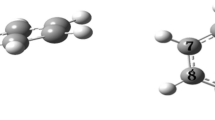Abstract
In this work, we present application of a previously proposed DFT-based computational protocol to a series of four push–pull type organic dyes for DSSC application, among which two are newly introduced here. Dyes investigated all use cyanoacrylic acid and dithiafulvene as the acceptor and donor subunits, respectively, and differ by their π-spacer: phenyl (DTF-C1), phenyl-thiophene-phenyl (DTF-C3), phenyl-furan-phenyl (DTF-C5), phenyl-N-ethyl pyrrole-phenyl (DTF-C6), making an investigation of the role of the π-bridge characteristics, including length and electronic structures, on the performances of DSSC systems possible. Investigated properties included UV–visible spectra of isolated dyes, and important macroscopic DSSC experimental data such as injection times, incident photon-to-current conversion efficiencies and short-circuit photocurrents derived from the adsorption of these dyes on a water-passivated TiO2 surface. Fairly good agreements between the computational and experimental results have been obtained. Furthermore, from the computed data, we predict that one of the newly introduced dyes is an excellent candidate for DSSC application, with expected photoconversion efficiencies higher than those previously achieved for this sensitizer series.





Similar content being viewed by others
References
O’Regan B, Grätzel M (1991) Nature 353:737
Hagfeldt A, Boschloo G, Sun L, Kloo L, Pettersson H (2010) Chem Rev 110:6595
Spitler MT, Parkinson BA (2009) Acc Chem Res 42:2017
Hagfeldt A, Grätzel M (1995) Chem Rev 95:49
Chia Y, Islam A, Watanable Y, Komiya R, Koide N, Han L (2006) Jpn J Appl Phys 45:638
Cao Y, Bai Y, Yu Q, Cheng Y, Liu S, Shi D, Gao F, Wang P (2009) J Phys Chem C 113:6290
Yella A, Lee HW, Tsao HN, Yi C, Chandiran AK, Nazeeruddin MK, Diau EWG, Yeh CY, Zakeeruddin SM, Grätzel M (2011) Science 334:629
Satoh N, Nakashima T, Yamamoto K (2005) J Am Chem Soc 127:13030
Wang ZS, Cui Y, Dan-oh Y, Kasada C, Shinpo A, Hara K (2007) J Phys Chem C 111:7224
Koumura N, Wang ZS, Mori S, Miyashita M, Suzuki E, Hara K (2006) J Am Chem Soc 128:41256
Wenger S, Bouit PA, Chen QL, Teuscher J, Censo DD, Humphry-Baker R, Moser JE, Delgado JL, Martin N, Zakeeruddin SM, Grätzel M (2010) J Am Chem Soc 132:5164
Meyers F, Bredas JL, Zyss J (1992) J Am Chem Soc 114:2914
De Lucas AI, Martin N, Sanchez L, Seoane C, Garin J, Orduna J, Alcala R, Villacampa B (1997) Tetrahedron Lett 38:6107
Blanchard-Desce M, Ledoux I, Lehn JM, Malthete J, Zyss J (1988) J Chem Soc Chem Commun (11):737–739
Joly D, Pellejà L, Narbey S, Oswald F, Chiron J, Clifford JN, Palomares E, Demadrille R (2014) Sci Rep 4:4033
Labat F, Le Bahers T, Ciofini I, Adamo C (2012) Acc Chem Res 45:1268
Guo K, Yan K, Lu X, Qiu Y, Liu Z, Sun J, Yan F, Guo W, Yang S (2012) Org Lett 14:2214
Labat F, Ciofini I, Adamo C (2011) J Phys Chem C 115:4297
Labat F, Ciofini I, Adamo C (2012) J Mater Chem 22:12205
Labat F, Ciofini I, Hratchian HP, Frisch M, Raghavachari K, Adamo C (2009) J Am Chem Soc 131:14290
Le Bahers T, Labat F, Lainé P, Pauporté T, Ciofini I (2011) J Am Chem Soc 133:8005
Le Bahers T, Pauporté T, Lainé P, Labat F, Adamo C, Ciofini I (2013) J Phys Chem Lett 4:1044
Frish MJ et al (2009) Gaussian 09, Revision A.02. Gaussian, Inc., Wallingford, CT
Adamo C, Barone V (1999) J Chem Phys 110:6158
Ernzerhof M, Scuseria G (1999) J Chem Phys 110:5029
Runge E, Gross EKU (1984) Phys Rev Lett 52:997
Stratmann RE, Scuseria GE, Frisch MJ (1998) J Chem Phys 109:8218
Yanari T, Tew D, Handy N (2004) Chem Phys Lett 393:51
Tomasi J, Mennucci B, Cammi R (2005) Chem Rev 105:2999
Mennucci B, Cancès E, Tomasi J (1997) J Phys Chem B 101:10506
Cossi M, Barone V (2001) J Chem Phys 115:4708
Dovesi R, Saunders V, Roetti C, Orlando R, Zicovich-Wilson C, Pascale F, Civalleri B, Doll K, Harrison N, Bush I, D’Arco P, Llunell M (2009) Crystal09. Unversità di Torino, Torino
Labat F, Ciofini I, Hratchian H, Frisch M, Raghavachari K, Adamo C (2011) J Phys Chem C 115:4297
Labat F, Baranek P, Adamo C (2008) J Chem Theory Comput 4:341
Labat F, Adamo C (2007) J Phys Chem C 111:15034
Newns DM (1969) Phys Rev 178:1123
Persson P, Lundqvist M, Ernstorfer R, Goddard W, Willig F (2006) J Chem Theory Comput 2:441
Walle LE, Borg A, Johansson EMJ, Plogmaker S, Rensmo H, Uvdal P, Sandell A (2011) J Phys Chem C 115:9545
Kalyanasundaram K, Grätzel M (1998) Coord Chem Rev 177:347
Nayak PK, Bisquert J, Cahen D (2011) Adv Mater 23:2870
De Angelis FD, Fantacci S, Selloni A, Grätzel M, Nazeeruddin MK (2007) Nano Lett 7:3189
Chen P, Yum JH, Angelis FD, Mosconi E, Fantacci S, Moon SJ, Baker RH, Ko J, Nazeeruddin MK, Grätzel M (2009) Nano Lett 9:2487
Author information
Authors and Affiliations
Corresponding author
Additional information
Published as part of the special collection of articles “Health & Energy from the Sun”.
Electronic supplementary material
Below is the link to the electronic supplementary material.
Rights and permissions
About this article
Cite this article
Xerri, B., Labat, F., Guo, K. et al. Investigating the role of the π-bridge characteristics in donor–π-spacer–acceptor type dyes for solar cell application: a theoretical study. Theor Chem Acc 135, 40 (2016). https://doi.org/10.1007/s00214-015-1748-x
Received:
Accepted:
Published:
DOI: https://doi.org/10.1007/s00214-015-1748-x




